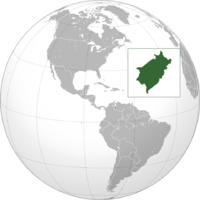State of Berin
First Berinese Empire | |||||||||
|---|---|---|---|---|---|---|---|---|---|
| Motto: Hecha de centenares de flores (Spanish: "Made of hundreds of flowers") | |||||||||
| Anthem: Sobre el joven Berin | |||||||||
 Venezuela | |||||||||
| Capital | San Alejandro | ||||||||
| Official languages | Spanish • English | ||||||||
| Demonym(s) | Berinese | ||||||||
| Government | Parliamentary constitutional monarchy | ||||||||
| Legislature | National Council | ||||||||
| Establishment | 6 June 2011 | ||||||||
| Population | |||||||||
• Census | 11 | ||||||||
| Currency | Lyre (₰) • Bolívar (Bs.F.) | ||||||||
| Time zone | (UTC-4:30) | ||||||||
| |||||||||
Berin, officially the Most Serene State of Berin (in Spanish: Serenísimo Estado del Berin), also commonly known as the First Berinese Empire (pronounced [βeɾin]) was a short-lived micronation of the Valtir Sector founded on 6 June 2011. It was established after the dissolution of Montblanc, and it collapsed on 18 August 2011 to be succeded by the First Berinese Republic.
It is of historical importance as it was the first micronation in the Valtir (Garrshirian) sector to be completely sockpuppeting and fantasy-free, and the first to become actively involved in the MicroWiki Community. It was a member of the Organisation of Active Micronations, the Union of South American Micronations (first incarnation) and a founding member of the Organisation of Micronational Ambient Protection.
History
The State of Berin was was established on 6 June 2011 with the name of Berinese Confederation (Confederación Berinesa, in Spanish) by Tarik Kârjasary after the dissolution of the Kingdom of Montblanc. Kârjasary, who had been King of Montblanc, declared himself Emperor of Berin, and established a constitutional parliamentary monarchy. The Berinese Confederation claimed a large part of Western Venezuela, and its capital was the same as Montblanc's: the city of San Alejandro, in what today is the Bal Prefecture.
The Berinese Confederation was quickly cemented as a democratic state by the election of a head of government, Juan de Arimatea, who became President of the Berinese Confederation. On 17 June 2011, the Minister for Wildlife Protection, Víctor Rosales, seized the Eastern territories of the Confederation and declared the Republic of Chipitocoland, which was subsequently recognized by the Imperial government of Berin.
On 28 July 2011, the name "Berinese Confederation" was scrapped and the nation was renamed as the "Most Serene State of Berin" (Serenísimo Estado del Berín), a name it retained until the Monarchy's dissolution. On 10 July 2011, the Emperor officially created the Berinese National Council, the unicameral parliament of the Confederation. The National Council issued the official declaration of Independence from Venezuela, and it gave rise to partisan politics in the State, with the creation of two political parties.
The State of Berin was divided into three Semi-Autonomous Provinces, Buque España, Zea and New Lapaz. These were divided into 23 municipalities.
Flags
During the monarchial regime in Berin, seven different flags were used. Each of them was officially elected, either by royal decrees or through a vote by the Berinese National Council. The first one of them was the 1:1 blue cross, similar to the flag of Switzerland. The blue cross over a white background was recognised as the heraldic symbol of Berin, and the blue cross design was used from the founding of the Berinese Confederation until its disestablishment. The second one was the Costa Rican style, similar to the flag of Costa Rica, with the same colors, but organised differently. The official design saw the Berinese arms in the centre. The third and fourth flags where equal, with the difference of the coat of arms. Those had a 1:2 white background with two red stripes located horizontally. The stripes where organized in a similar way to the Costa Rican style. The fifth flag was similar to the Belgian flag, with the same proportions, but different colors. This flag used the colors of the Venezuelan flag, with a Sun of May or Inca sun in the centre. The flag of the State of Berin, the successor of the Berinese Confederation, was a blue and white 3:4 ensign, formed by two vertical stripes, with a small coat of arms positioned in the centre. All the flags tended to have the same symbolism: blue for the sky and the rain, red for courage, richness and kindness and white for peace, neutrality and equality.
-
6–24 June 2011
-
24–27 June 2011
-
27 June - 2 July 2011
-
2–4 July 2011
-
4–13 July 2011
-
13 July - 1 August 2011
-
1–18 August 2011
-
Flag of the former Berinese Royal Family







